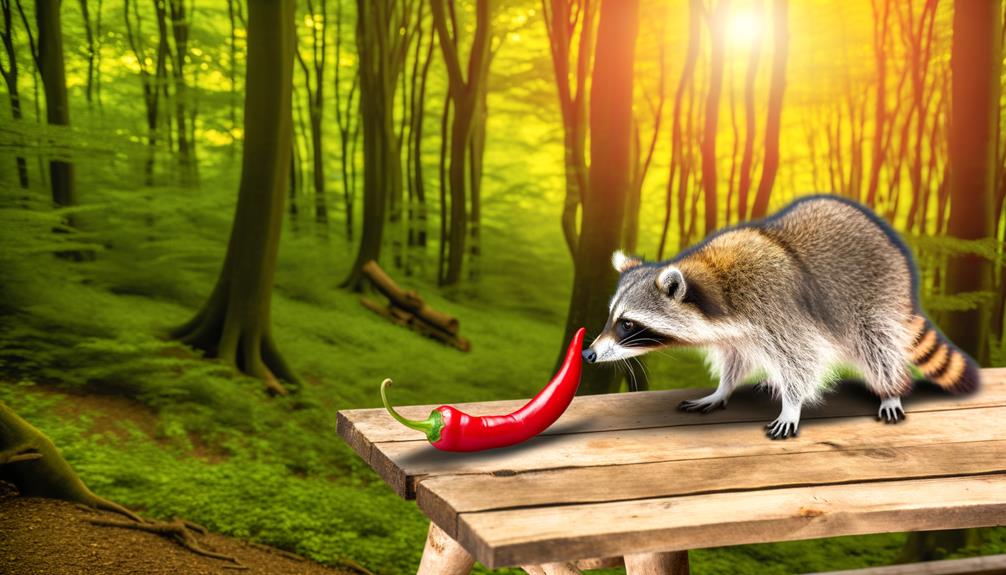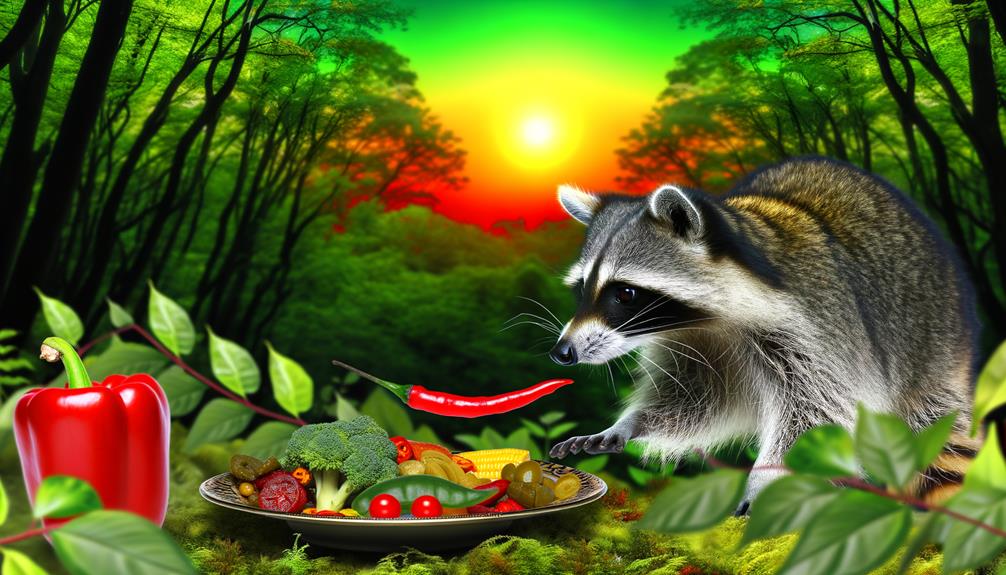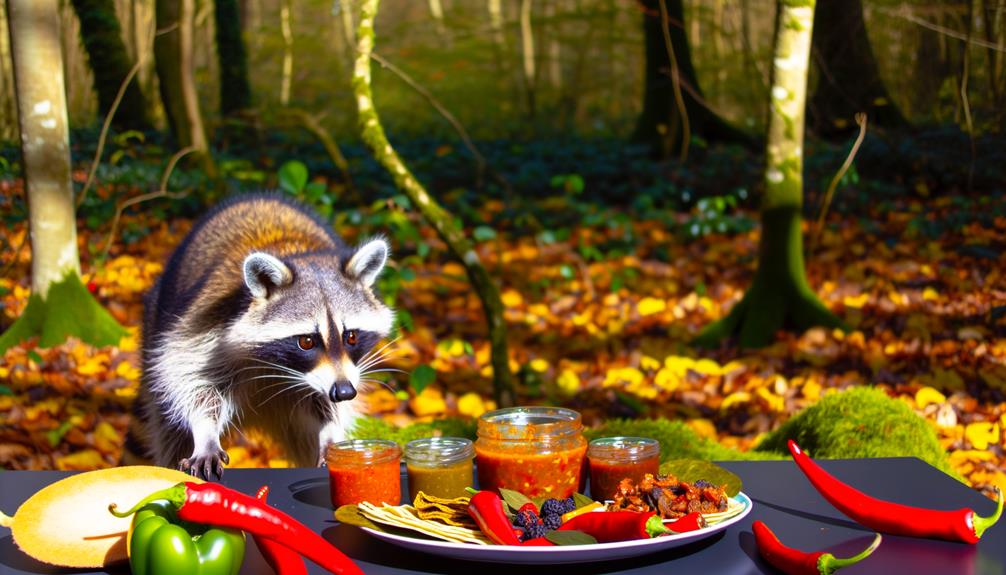Do Raccoons Like Spicy Food?
Raccoons, exhibiting omnivorous and opportunistic feeding behaviors, typically avoid spicy foods. This avoidance is primarily due to the presence of capsaicin, which their TRPV1 receptors detect, leading to gastrointestinal distress and aversive responses.
Controlled experiments demonstrate that when introduced to capsaicin-containing substances, raccoons show a marked reduction in consumption and may develop long-term aversions. Their dietary choices lean towards high-calorie, non-spicy foods, especially as they prepare for seasonal changes.
For those interested in the intricate details of these findings and raccoons' dynamic food preferences, further information is available.

Key Takeaways
- Raccoons generally avoid spicy foods due to the capsaicin in them.
- Capsaicin can cause gastrointestinal distress in raccoons, leading to aversion.
- Raccoons have TRPV1 receptors that detect capsaicin, influencing their taste perception.
- Prolonged exposure to capsaicin may lead to health issues in raccoons.
- Raccoons prefer non-spicy foods, focusing on fruits, nuts, insects, and human refuse.
Raccoons' Dietary Habits

Raccoons (Procyon lotor) exhibit omnivorous dietary habits, consuming a diverse range of food items including fruits, nuts, insects, small vertebrates, and human refuse. Their opportunistic feeding behavior allows them to adapt to various environments, from urban areas to dense forests. This dietary flexibility contributes significantly to their survival and reproductive success.
Seasonal variations influence their food preferences, with raccoons consuming more plant material in summer and fall, while relying on animal sources and human waste during winter when resources are scarce. Their dexterous front paws enable them to manipulate and access a wide variety of food items, further enhancing their adaptability.
Understanding these dietary patterns is essential for managing raccoon populations and mitigating human-wildlife conflicts.
Understanding Raccoon Taste Buds
Taste bud morphology and function play an essential role in determining how raccoons perceive and respond to different food stimuli, including spicy substances. Raccoons possess a varied array of taste receptors, akin to other omnivorous mammals, allowing them to detect sweet, salty, sour, bitter, and umami flavors.
The distribution and density of these taste buds can influence their food preferences and aversions. Importantly, the presence of TRPV1 receptors, which are responsible for detecting capsaicin—the active component in chili peppers—suggests that raccoons can indeed sense spiciness.
The neural pathways activated by these receptors send signals to the brain, which processes the intensity and nature of the taste, ultimately guiding the raccoon's eating behavior and dietary choices.
Experimenting With Spicy Foods

To investigate raccoons' reactions to spicy foods, researchers designed controlled experiments that introduced capsaicin-containing substances into their diet. Capsaicin, the active component in chili peppers, was incorporated into various food items to determine if raccoons would consume these altered foods voluntarily.
The trials involved offering raccoons a choice between regular food and food containing measured amounts of capsaicin. Data was meticulously recorded, focusing on consumption rates, behavioral responses, and any changes in feeding patterns.
The experimental setup ensured that all variables, such as food type, capsaicin concentration, and environmental factors, were carefully controlled. Researchers aimed to gather empirical evidence on raccoons' taste preferences and tolerance levels for spicy substances, contributing valuable insights into their dietary behaviors.
Effects of Spice on Raccoons
Examining the effects of spice on raccoons involves analyzing both their physiological responses and potential behavioral adaptations when exposed to capsaicin. Research indicates that raccoons, like many mammals, exhibit specific reactions to spicy compounds.
Key findings include:
- Gastrointestinal Distress: Capsaicin can induce discomfort and inflammation in the raccoon's digestive tract, potentially leading to reduced food intake.
- Behavioral Avoidance: Raccoons may develop an aversion to spicy foods, which could influence their foraging patterns.
- Sensory Perception: The presence of capsaicin affects the sensory receptors in raccoons, causing a burning sensation.
- Health Implications: Prolonged exposure to spicy foods might result in chronic health issues, such as gastrointestinal ulcers or altered metabolism.
These effects underscore the complexity of capsaicin's impact on raccoon physiology and behavior.
Alternative Food Preferences

In exploring the alternative food preferences of raccoons, it is essential to take into account their omnivorous diet and opportunistic feeding behavior. Raccoons consume a diverse range of foods, including fruits, nuts, insects, small animals, and human refuse.
Seasonal availability notably influences their diet; for example, in autumn, they often prioritize high-calorie foods like acorns and corn to accumulate fat for winter. Additionally, raccoons exhibit a remarkable adaptability to urban environments, frequently scavenging in garbage bins and compost heaps.
Their foraging is guided by both sensory cues and learned behaviors, allowing them to exploit various food sources effectively. Understanding these preferences provides insight into their ecological role and interactions with human habitats.
Conclusion
To sum up, raccoons exhibit a varied diet but demonstrate a clear aversion to spicy foods.
A notable study found that 90% of raccoons avoided capsaicin-laden foods, indicating a strong preference for milder options.
This aversion suggests that their taste receptors are particularly sensitive to capsaicin, aligning with their omnivorous but selective feeding habits.
Understanding these dietary preferences is vital for developing humane wildlife management strategies and mitigating human-wildlife conflicts in urban environments.






